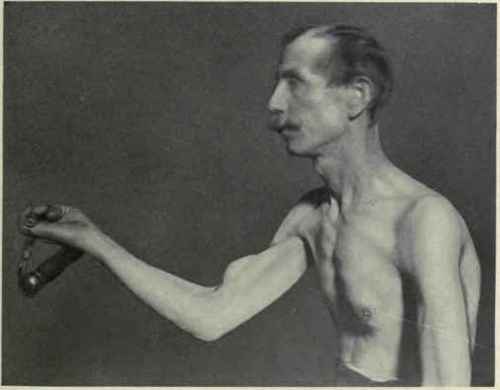Muscles Of The Arm
Description
This section is from the book "Applied Anatomy: The Construction Of The Human Body", by Gwilym G. Davis. Also available from Amazon: Applied anatomy: The construction of the human body.
Muscles Of The Arm
In order to operate intelligently it is necessary to know the muscles and interspaces, for the latter carry important structures. The arm possesses four sets of muscles. One, an external set, abducts it, the deltoid; another, or internal set, ad-ducts it (and rotates it inward), the pectoralis major, teres major, latissimus dorsi, (and coracobrachialis; another, anterior set, flexes the forearm, the biceps, and the brachualis anticus; and the last, or posterior set, extends the forearm, the triceps, with, sometimes, the subanconeus beneath it.
The External, or Abductor Set
This comprises only one muscle, the deltoid; the supraspinatus belongs to the shoulder region.
The deltoid forms the large rounded prominence of the shoulder. At its insertion the bone is nearest the surface and can be most readily felt. The posterior edge can be plainly seen when contracted running upward and inward and crossing the posterior fold of the axilla at right angles. Its anterior edge blends more or less completely with the pectoralis major (Fig. 279).

Fig. 280. - Anterior view of muscles of the arm.
The Internal Set. The internal set includes the coracobrachialis, with the short head of the biceps, and the pectoralis major, teres major, and latissimus dorsi.
The coracobrachialis arises from the coracoid process and tendon of the short head of the biceps and inserts on the inner surface of the humerus for a distance 5 to 7.5 cm. (2 to 3 in.) opposite the insertion of the deltoid, but extending a little lower. In its course from the coracoid process, in its lower part, it is subcutaneous and produces a distinct muscular prominence along the anterior border of the axilla. It occupies about one-third of the width of the axilla and is a guide to the brachial artery. Below the edge of the anterior axillary fold it dips down to insert into the bone and is covered by the biceps muscle. The inner edge of the coracobrachialis is continuous with the inner edge of the biceps. When it contracts it adducts the humerus and brings it forward.
The pectoralis major, forming the anterior axillary fold, inserts into the external lip of the bicipital groove from the greater tuberosity above to the insertion of the deltoid below. The tendon is twisted on itself so that the lowest fibres at its origin are inserted the highest, and the highest in origin are the lowest at their insertion.
The latissimus dorsi and teres major form the posterior axillary fold and their manner of insertion resembles that of the pectoralis major. The tendon of the latissimus dorsi inserts into the bottom of the bicipital groove higher up than the teres major. Hence near the humerus the lower edge of the posterior axillary fold is formed by the teres major and its lower border marks the lower limit of the axillary and the beginning of the brachial artery.

Pig. 281. - Rupture of the tendon of the long head of the biceps muscle, producing a swelling comparatively low down.
As the pectoralis major, latissimus dorsi, and teres minor muscles insert on the anterior surface of the humerus, they tend to rotate it inward as well as to adduct it.
Continue to:


